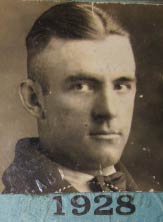Don Mathers (Source: Tietz)
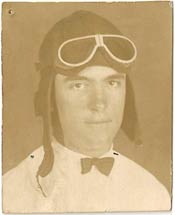 |
Register pilot Don Sherlock Mathers was born March 18, 1905. He learned to fly in 1924 at Rosecrans Field in northwestern Missouri. The airport was named in honor of Sgt. Guy W. Rosecrans "and comrades" of the 153rd Aero Squadron, U.S. Army, 1917-18. The portrait, left, and all other photographs and information on this page are shared with us by pilot Mathers' daughter (cited, right sidebar).
Mathers was born at the right place at the right time to join the legion of barnstorming pilots of the 1920s. His career during the 1920s consisted of moving from one flight organization to another, flying people for business or recreation, promotion and aerial advertising. He also got his ticket punched working for a manufacturer (American Eagle) ferrying and promoting their aircraft. As the decade closed, he joined the twenty-nine contestants signed up for the Fifth National Ford Reliability Tour in October, 1929.
The photographs, artifacts, news articles and anecdotes shared by his daughter are exhibited below in more or less chronological order, leaving us with an excellent understanding of the day-to-day activities of this Golden Age pilot, as well as insight into his "pioneer cussedness."
Below, a photograph of Mathers from 1924.
Don Mathers, 1924, Location Unknown (Source: Tietz)
 |
Below, another photograph of Mathers from July, 1925. Note the advertising occupying nearly every square inch of the fuselage. Compare this with the fuselage of fellow Register pilot Mel Aavang's Canuck.
Don Mathers, 1925, Location Unknown (Source: Tietz)
 |
Ride Ticket, Ca. Late 1920s (Source: Tietz)
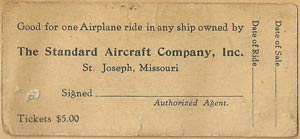 |
News Article, 1926, Mathers Appointed Pilot (Source: Tietz)
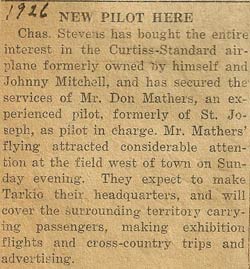 |
In 1926, Mathers was hired by Curtiss-Standard Aircraft Company as "pilot in charge." Curtiss-Standard was headquartered in Tarkio, MO. It covered the surrounding territory, carrying passengers, making exhibition flights and cross-country trips, and advertising. Above, a ride ticket for the organization. At right, a news article announcing Mathers' appontment as pilot.
Also in 1926, Mathers was found testing the air space laws in Nebraska. He was arrested for "trespassing" while flying low over a farmer's field. It was the first time in Nebraska that such an arrest had been made. Below, two undated news articles from 1926 that give some details. Exactly how much air DID belong to the farmer?
News Articles, 1926 (Source: Tietz)
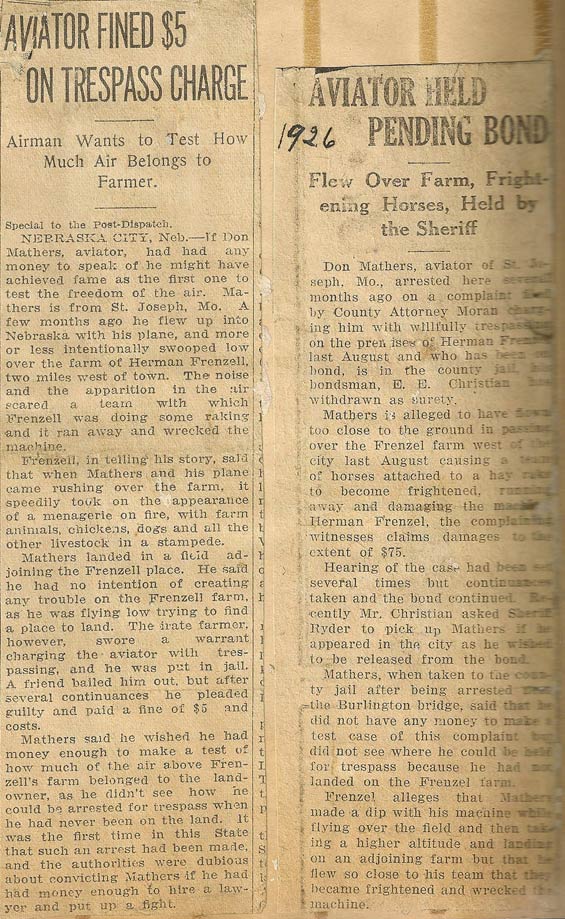 |
Nowadays, such uncertainty is dealt with by the FAA issuing what are called TFRs, or Temporary Flight Restrictions, over areas of special interest or particular danger, like the White House, or Cape Canaveral during a rocket launch. It is clearly illegal, with federal penalties, to breach the boundaries of a TFR with an aircraft.
Ride Ticket, Ca. Late 1920s (Source: Tietz)
 |
In 1927 Mathers was pilot and flying instructor for Nebraskan Airways Transport company in Lincoln, NB. Ride ticket at right. As a publicity stunt for the film "Now We're in the Air," he and his mechanic Nick Ericson flew over Columbus, OH in an Arrow 5 dropping more than 500 handbills. Twenty-five of those handbills served as free admission to the Swan theater for the film. They spent three or four days at Columbus taking passengers for flights over the city. They used a pasture as a landing field. Interestingly, "Now We're in the Air" (1927) starred fellow Register pilot Wallace Beery. Below, the "Nebraska Airways Force" stands in front of their Arrow 5. Their exploits were cited in a couple of news articles from Mathers' album.
Nebraska Airways Force, Arrow 5, Ca. 1927 (Source: Tietz)
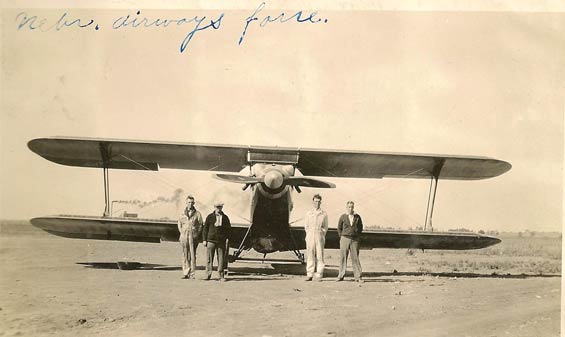 |
Below, Mathers stands at left. The others are unidentified.
Nebraska Airways Force, Arrow 5, Ca. 1927 (Source: Tietz)
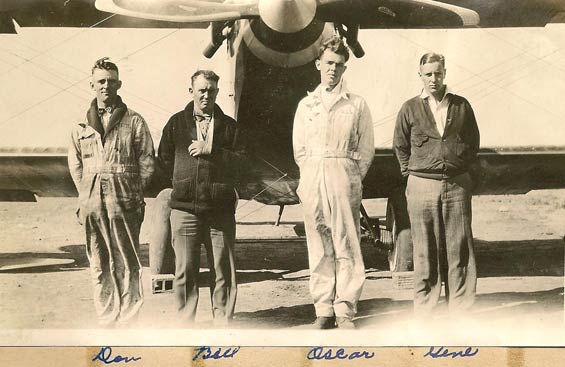 |
The following three images from the same page of his album depict two different aircraft at an unknown location. The first two are identified as an Arrow 5 by Mathers. They may have been taken at Columbus, OH. The last one is identifiable as American Eagle NC5804 (not a Register airplane). The barrel below held gasoline or perhaps water for the water cooled engine (note the radiator above the fuselage in front of the cockpit).
Arrow 5, Ca. Late 1920s (Source: Tietz)
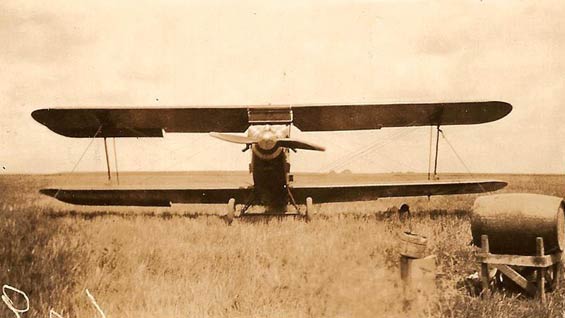 |
Below, Mathers annotated this photo with, "This is me landing with 4 passengers (Arrow 5) after taking pictures from 2200 ft. altitude."
Arrow 5, Ca. Late 1920s (Source: Tietz)
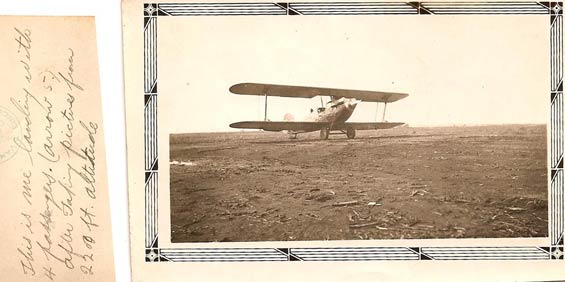 |
Below, the American Eagle NC5804.
American Eagle NC5804, Ca. Late 1920s (Source: Tietz)
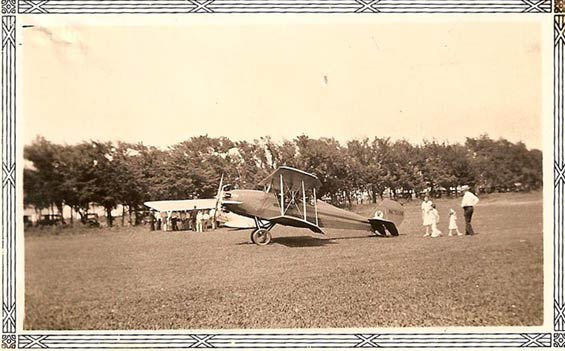 |
Undated/Unsourced News Article, Ca. 1929 (Source: Tietz)
 |
The Porterfield Flying School had been established July 4, 1925 by E.E. Porterfield. It was later acquired by Universal Aviation Corporation. At right is an undated but probably mid-1929) and unsourced article that tells of the acquisition.
In 1929 he resigned his job with Porterfield to become assistant test pilot and demonstrator for the American Eagle Aircraft Corporation. For two years Mathers was chief instructor for the American Eagle Flying Company at the Fairfax Airport. He served as test pilot and district sales pilot for American Eagle. A comment was made as to how dangerous his job was. He responded, "Well, I test airplanes all day, and I'm more afraid to drive my car home at night."
Below, and aerial view of the Fairfax Airport. Compare with the ground view below.
Fairfax Airport, 1929 (Source: Tietz)
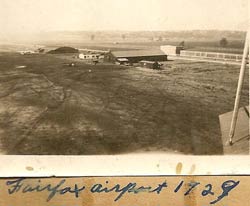 |
Below, two unsourced news articles which describe Mathers' district sales activities.
Northeast District Promotional Flight, Ca. 1929 (Source: Tietz)
.jpg) |
Midwest District Promotional Flight, Ca. 1929 (Source: Tietz)
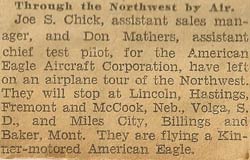 |
Below, one of the liners of Universal. This airplane flew the route from Fairfax Airport to Kansas City. The registration number is unreadable. Note the logo on the fuselage.
Fokker Liner, Universal Air Lines System, Ca. 1929 (Source: Tietz)
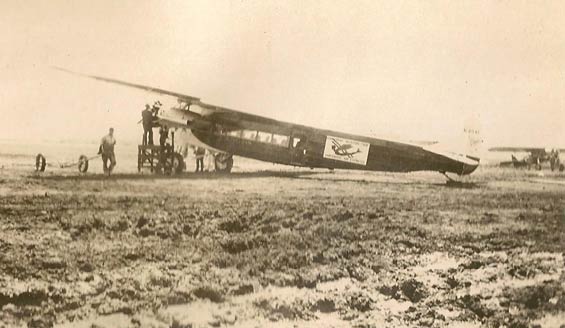 |
Universal Air Lines System Logo, Ca. 1928 (Source: Webmaster)
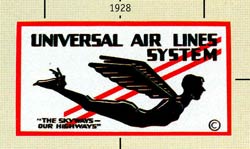 |
The interesting Universal Air Lines System logo is shown at right. Their motto: "The Skyways Our Highways."
About this time, and probably in association with his duties for American Eagle, Mathers landed once at Tucson, Wednesday, May 22, 1929 at 11:45 AM. He was westbound from Kansas City, Fairfax Field, to Los Angeles, CA. He flew American Eagle NC808E carrying one unidentified passenger. He noted in the remarks column of the Register, "Good field."
Kinner Motor Company Visitor's Badge, May 24, 1929(?) Source: Tietz
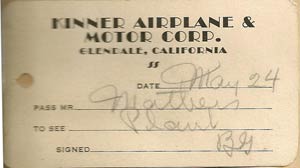 |
At left, a visitor's badge for the Kinner Airplane & Motor Corp. dated May 24. It is not too much of a stretch to guess the year being 1929. This would place Mathers at Grand Central Air Terminal, Glendale, two days after his visit at Tucson. Further, his American Eagle was powered by a Kinner engine.
Below, pilot Mathers in the cockpit of NC808E. The engine appears to be running and a pilot is in the cockpit. "Porterfield Flying School" is painted on the building behind the airplane. The school was located at Richards Airport in Kansas City (link, above) and its owner, Edward Porterfield, built the American Eagle aircraft.
Don Mathers and NC808E, Ca. 1929 (Source: Tietz)
.jpg) |
American Eagle aircraft were manufactured in Kansas City. Although I have no information about Mathers' airplane, several American Eagles are represented on this site. For example, NC3887, NC6970, NC7103 and NC7176.
Below, another view of an American Eagle aircraft at Oklahoma City, OK. While it looks like the same paint scheme, it is not possible to know if it is 808E. The bullet-shaped nose of the airplane gave it a sleek appearance.
American Eagle Airplane, Oklahoma City, OK, Ca. 1929 (Source: Tietz)
 |
From the unsourced and undated news article below, he might have been ferrying a brand new American Eagle aircraft when he passed through Tucson to pilot, "... a Kinner powered American Eagle biplane to Los Angeles."
News Article, Source and Date Unknown (Source: Tietz)
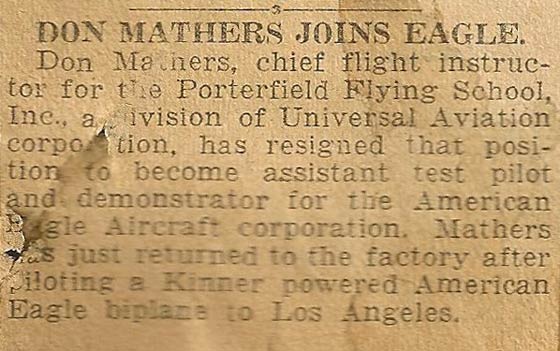 |
Participant Button, National Air Tour, 1929 (Source: Tietz)
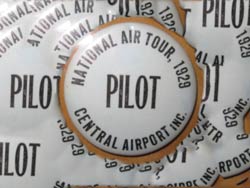 |
Later in 1929 he participated in the Ford Reliability Tour. With race number 10, he flew NC744K, a Wallace Touroplane B-330 (S/N 14). He carried E.M. Southwood as his mechanic. At left is an official Tour identification button worn by pilots. The round button is at the middle of the image. The rest of it is an artifact of PhotoShop that I thought was interesting so I left it alone.
Below, a photograph of NC744K (not a Register airplane) at the start of the Tour at Dearborn, MI. In the original, you can just make out the registration number on the top of the right wing.
Don Mathers in Wallace Touroplane B-330, Dearborn, MI, October 5, 1929 (Source: Tietz)
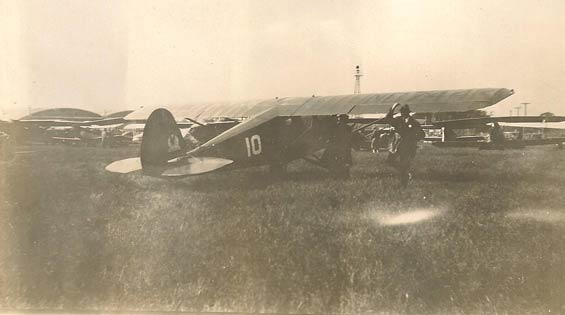 |
Alas, he crash landed his airplane (no one injured) upon departure (after a breakfast of fried oysters) from the fourth stop at Baltimore, MD, Logan Field. Below, the aftermath.
Don Mathers' Wallace Touroplane B-330, Baltimore, MD, October 10, 1929 (Source: Tietz)
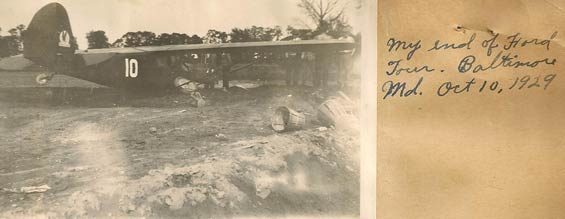 |
Details of Forced Landing, Unsourced & Undated News Article (Source: Tietz)
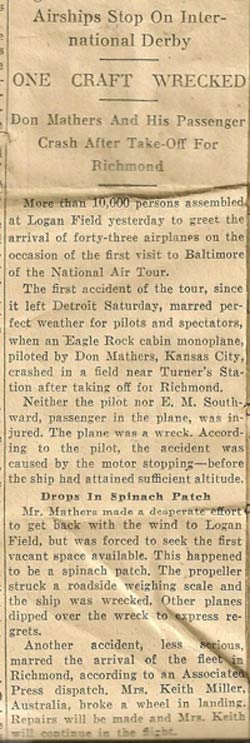 |
NAA Pilot Identification Card, National Air Tour, 1929 (Source: Tietz)
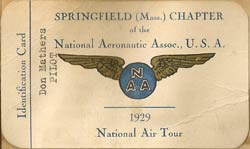 |
At right, Mathers' NAA ID card for the Tour.
According to the Baltimore News of October 9, 1929, Mathers was departing Logan Field headed south for Richmond, VA on the fifth leg of the Tour when the "motor went dead" and he was forced into a spinach field after clipping the edge of a concrete roadway under construction and shearing off the landing gear. The spinach was probably packed in the baskets visible in the photograph above.
Notably, his fellow competitors were a heady group, including some Register pilots: Wiley Post, George Haldeman, John Livingston, J.W. Welborn, Charley Meyers and Newman Wadlow. He would not join them for the ham dinner at Richmond that evening.
Briefly in 1929, Mathers was involved in the Yellow Cab Air Company. The intention was to povide on-demand air service to customers, flying them anywhere they wanted to go -- a custom charter operation as it were.
Yellow Cab Air Company, Ca. 1929 (Source: Tietz)
 |
Yellow Cab (right) owned equipment valued at $225,000, including a 150-acre landing field. The equipment included air taxis and automobiles to transport passengers from their home to the airport. The air taxi service was offered at ten cents per air mile for each passenger.
Based at Wichita, KS and flying out of Alliance, the company was granted a charter in May, 1929. Yellow Cab stayed in business about a year. The stock market crash that October, and the Depression that followed, nearly wiped out the aviation industry in Wichita, which was once known as "The Air Capital of the World." By 1931 only a handful of an original two-dozen aircraft manufacturers were still operating in the city. But, while it was in operation, a couple of news articles cite the usefulness of the Yellow Cab service. One example involved two oil men flown from Oklahoma City to New Mexico to handle urgent business. The men completed their business and returned home the same day.
In May, 1930, Mathers and his wife of two years, were flying a six-passenger monoplane, "to wave to his parents." The Stinson Detroiter was owned by Yellow Cab Airways. The cause and aftermath of the crash are described in the news article, ca. 1930, below. The first thing he did was cut the Airways logo off the tail to avoid bad publicity.
Mathers' Crash, Unsourced News Article, Ca. 1930 (Source: Tietz)
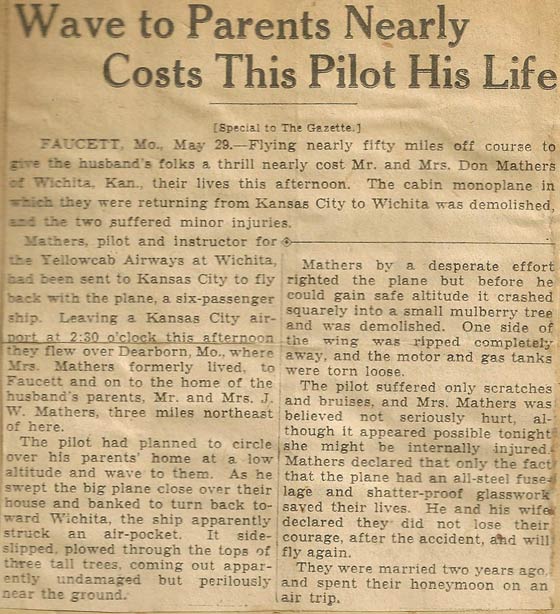 |
Ms. Tietz says, "I remember my mother saying that her heels went completely through the wooden floor of the plane. The newspaper article says they declared they did not lose their courage and would fly again, however my mother never did." The couple were very fortunate.
Mathers' Crash, Stinson Detroiter, Ca. May, 1930 (Source: Tietz)
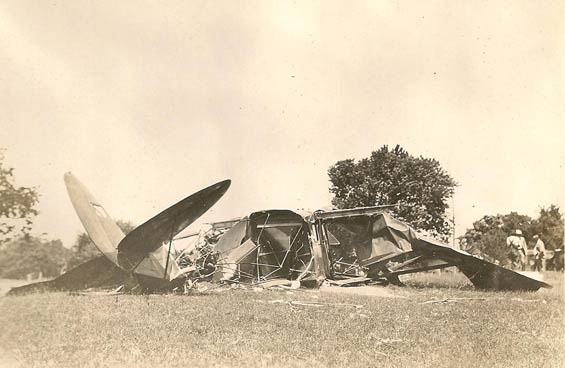 |
The extent of damage to the airplane, above and below, would suggest worse injuries. Notice that, because of the steel tube structure and safety glass, the area of the cockpit and passenger compartment maintained its integrity pretty well, as Mathers stated in the article. This is a good example of "crumple zones," fortuitous for the airplane and occupants then, but purposely engineered today into modern automobiles. They were further lucky because there was no fire.
Mathers' Crash, Stinson Detroiter, Ca. May, 1930 (Source: Tietz)
 |
Below, right, Mrs. Rosemary Mathers, labeled in the photo album as "Wife."
Rosemary Mathers, Date & Location Unknown (Source: Tietz)
 |
Dorothy states that her father, "... pretty much quit flying when the Depression came. One of his licences is dated up until 1934. He went to Agency, Missouri [small town in the northwest part of the state] and worked on his parent's farm until the late 30's. Then he bought an over the road truck and became a self employed long haul truck driver.
He suffered a heart attack while trying to start his motor boat at Lake Contrary, MO....the same place he first learned to fly. Mathers died at 49 years old on July 31, 1954.
One last photo from Mathers' album was taken at Alma, MI in 1928. It shows on the left a Waco 9, (NC)1088, S/N 326. On the right is American Eagle A-1, (NC)3884, S/N 87. Neither of these are Register aircraft, but I include the photo here because it represents a typical scene at a Golden Age airfield.
Waco 9 (R) and American Eagle, Alma, MI, 1928 (Source: Tietz)
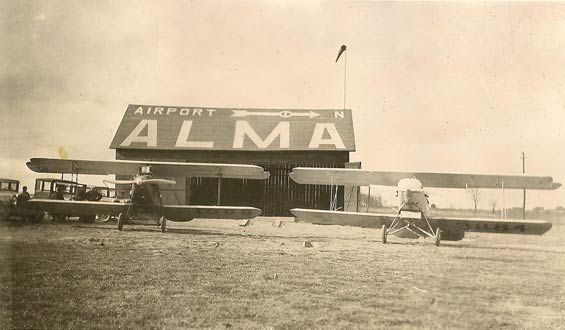 |
Note the similarities and differences between the aircraft. Both have OX-5 engines and elephant ear flaps. The radiator on the Waco is above the engine cowl. On the American Eagle, the radiator is below the cowl.
---o0o---
THIS PAGE UPLOADED: 03/14/11 REVISED: 12/25/22
|
















.jpg)




.jpg)












